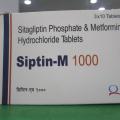Home / Categories / SITAGLIP-M 1050

SITAGLIP-M 1050
(10X10)
METFORMIN-1000MG
SITAGLIPTIN-50MG
ORAL HYPOGLYCEMIC DRUGS-BIGUANIDES & DIPEPTYL PEPTIDASE-IV INHIBITORS
DJPL-SUSWASTHYA DIVISON
Product Details
Sitagliptin is a new oral hypoglycemic (anti-diabetic drug) of the new dipeptidyl peptidase-4 (DPP-4) inhibitor class of drugs. This enzyme-inhibiting drug is to be used either alone or in combination with metformin or a thiazolidinedione for control of type 2 diabetes mellitus. The drug works to competitively inhibit a protein/enzyme, dipeptidyl peptidase 4 (DPP-4), that results in an increased amount of active incretins (GLP-1 and GIP), reduced amount of release of glucagon (diminishes its release) and increased release of insulin.
Indication
For use as an adjunct to diet and exercise to improve glycemic control in patients with type 2 diabetes mellitus. Also for use in patients with type 2 diabetes mellitus to improve glycemic control in combination with metformin or a PPARγ agonist (e.g., thiazolidinediones) when the single agent alone, with diet and exercise, does not provide adequate glycemic control.
Associated Conditions
Pharmacodynamics
Sitagliptin is an orally-active member of the new dipeptidyl peptidase-4 (DPP-4) inhibitor class of drugs. The benefit of this medicine is expected to be its lower side-effects of hypoglycemia in the control of blood glucose values. The drug works to diminish the effects of a protein/enzyme (by the inhibition of this protein/enzyme) on the pancreas at the level of release of glucagon (diminishes its release) and at the level of insulin (increases its synthesis and release) until blood glucose levels are restored toward normal, in which case the protein/enzyme-enzyme inhibitor becomes less effective and the amounts of insulin released diminishes thus diminishing the "overshoot" of hypoglycemia seen in other oral hypoglycemic agents.
Mechanism of action
Sitagliptin is a highly selective DPP-4 inhibitor, which is believed to exert its actions in patients with type 2 diabetes by slowing the inactivation of incretin hormones, thereby increasing the concentration and prolonging the action of these hormones. Incretin hormones, including glucagon-like peptide-1 (GLP-1) and glucose-dependent insulinotropic polypeptide (GIP), are released by the intestine throughout the day, and levels are increased in response to a meal. These hormones are rapidly inactivated by the enzyme, DPP-4. The incretins are part of an endogenous system involved in the physiologic regulation of glucose homeostasis. When blood glucose concentrations are normal or elevated, GLP-1 and GIP increase insulin synthesis and release from pancreatic beta cells by intracellular signaling pathways involving cyclic AMP. GLP-1 also lowers glucagon secretion from pancreatic alpha cells, leading to reduced hepatic glucose production. By increasing and prolonging active incretin levels, sitagliptin increases insulin release and decreases glucagon levels in the circulation in a glucose-dependent manner. These changes lead to a decrease in hemoglobin A1c (HbA1c)levels, as well as a lower fasting and postprandial glucose concentration. Sitagliptin demonstrates selectivity for DPP-4 and does not inhibit DPP-8 or DPP-9 activity in vitro at concentrations approximating those from therapeutic doses.
Absorption
Rapidly absorbed following oral administration, with an absolute bioavailability of 87%.
Volume of distribution
- 198 L [healthy subjects]
Protein binding
The fraction of sitagliptin reversibly bound to plasma proteins is low (38%).
Metabolism
Sitagliptin does not undergo extensive metabolism. In vitro studies indicate that the primary enzyme responsible for the limited metabolism of sitagliptin was CYP3A4 (oxidation), with contribution from CYP2C8.
Route of elimination
Approximately 79% of sitagliptin is excreted unchanged in the urine with metabolism being a minor pathway of elimination. Following administration of an oral [14C]sitagliptin dose to healthy subjects, approximately 100% of the administered radioactivity was eliminated in feces (13%) or urine (87%) within one week of dosing. Elimination of sitagliptin occurs primarily via renal excretion and involves active tubular secretion.
Half life
12.4 hours
Clearance
- renal cl=350 mL/min [Healthy subjects receiving 100 mg oral dose]
Toxicity
Not Available
Affected organisms
- Humans and other mammals
SOURCE:DRUGBANK
Metformin Hydrochloride
A to Z Drug Facts
| Metformin Hydrochloride |
| (met-FORE-min HIGH-droe-KLOR-ide) |
| Glucophage |
| Tablets: 500 mg, 850 mg |
| Glucophage XR |
| Tablets, extended-release: 500 mg |
| Apo-Metformin |
| Gen-Metformin |
| Class: Antidiabetic, Biguanide |
 Action Decreases blood glucose by decreasing hepatic glucose production. May also decrease intestinal absorption of glucose and increase response to insulin.
Action Decreases blood glucose by decreasing hepatic glucose production. May also decrease intestinal absorption of glucose and increase response to insulin.
 Indications Adjunct to diet to lower blood glucose in patients with type 2 diabetes mellitus whose hyperglycemia cannot be controlled by diet alone.
Indications Adjunct to diet to lower blood glucose in patients with type 2 diabetes mellitus whose hyperglycemia cannot be controlled by diet alone.
 Contraindications Renal disease or dysfunction as suggested by serum creatinine > 1.5 mg/dL in males or > 1.4 mg/dL in females or abnormal Ccr; conditions which predispose to renal dysfunction (eg, cardiovascular collapse, acute MI, septicemia); in patients undergoing radiologic studies involving parenteral administration of iodinated contrast material (potential to acutely alter renal function); acute or chronic metabolic acidosis, including diabetic ketoacidosis.
Contraindications Renal disease or dysfunction as suggested by serum creatinine > 1.5 mg/dL in males or > 1.4 mg/dL in females or abnormal Ccr; conditions which predispose to renal dysfunction (eg, cardiovascular collapse, acute MI, septicemia); in patients undergoing radiologic studies involving parenteral administration of iodinated contrast material (potential to acutely alter renal function); acute or chronic metabolic acidosis, including diabetic ketoacidosis.
ADULTS: Initial dose: PO 500 mg bid, increase by 500 mg q wk (max, 2500 mg/day in divided doses).
ADULTS: Initial dose: PO 850 mg qd, increase by 850 mg q 2 wk (max, 2550 mg/day in divided doses).
ADULTS: Glucophage XR Initial dose: PO 500 mg qd with evening meal, increase by 500 mg q wk (max, 2000 mg once daily). If higher doses of metformin are required, administer at total daily dose up to 2500 mg in divided daily doses as described above.
Alcohol
Potentiates effect of metformin on lactate metabolism.
Cationic Drugs (eg, Amiloride, Digoxin, Quinidine)
May increase metformin serum concentration by competing for tubular secretion.
Cimetidine
Increases metformin serum concentration.
Furosemide
May increase metformin serum concentration; metformin may reduce furosemide serum concentration.
Iodinated Contrast Material
May cause acute renal failure and has been associated with lactic acidosis in patients receiving metformin.
Nifedipine
Increases metformin serum concentration.
 Lab Test Interferences None well documented.
Lab Test Interferences None well documented.
EENT: Unpleasant/metallic taste. GI: Diarrhea; nausea; vomiting; abdominal bloating; flatulence; anorexia. METABOLIC: Lactic acidosis. OTHER: Subnormal vitamin B12 levels.
Pregnancy: Category B. Insulin is recommended to maintain blood glucose levels during pregnancy. Lactation: Undetermined. Children: Safety and efficacy not established. Elderly: Use with caution. Maximum doses are generally not used because of age-related decreases in renal function. Lactic Acidosis: Can occur and be fatal in » 50% of cases, as a result of metformin accumulation (eg, renal impairment) or with pathophysiologic conditions associated with tissue hypoperfusion and hypoxia. The risk of lactic acidosis increases with the degree of renal dysfunction and the patient’s age. Renal Impairment: Decreased renal function results in decreased renal clearance and prolongation of the metformin half-life. Concomitant medications that affect renal function, result in significant hemodynamic changes or interfere with disposition of metformin (eg, cationic drugs eliminated by renal tubular secretion) should be used with caution. Hepatic Disease: Avoid metformin in patients with clinical or laboratory evidence of hepatic disease. GI Symptoms: GI symptoms occurring after a patient is stabilized on metformin are unlikely to be drug related but could be because of lactic acidosis or other serious disease. Iodinated Contrast Material: Withhold metformin for ³ 48 hr before parenteral contrast studies with iodinated materials. Reinstitute therapy 48 hr after the study and after renal function has been determined to be normal.
| PATIENT CARE CONSIDERATIONS |
|
- Administer in divided doses with meals starting with a low dose with gradual escalation of dose.
- Dosage of metformin should be individualized on basis of effectiveness and tolerance.
- Ensure determination of fasting plasma level prior to initial dose to ascertain therapeutic response to metformin.
- Metformin can be administered alone or in combination with a sulfonylurea.
- Monitor for possible hypoglycemic effects.
- A reduced dose may be needed in elderly and debilitated or malnourished patients.
- Monitor blood glucose as indicated to ensure blood sugar control; measure glycosylated hemoglobin at intervals of » 3 mo.
- Do not administer during pregnancy; insulin is usually given.
- Obtain patient history.
- Monitor patient for signs and symptoms of hypoglycemia.
- Assess for potential drug-drug interactions. A patient receiving hyperglycemic agents should be closely monitored to maintain adequate glycemic control.
- Assess patient for high risk factors for lactic acidosis.
- Do not use metformin if patient is to have an x-ray procedure with contrast dyes or surgery.
- Should the patient become ill, review laboratory studies as indicated for abnormalities in serum electrolytes, CBC, and blood glucose levels for signs of acidosis and dehydration.
- Assess for GI symptoms, especially with higher doses.
- When transferring from standard oral hypoglycemic agents, other than chlorpropamide, no transition period is usually necessary; however, when transferring from chlorpropamide, care should be exercised during the first 2 wk because of the long retention of chlorpropamide in the body, leading to overlapping drug effects and possible hypoglycemia.
- Determine possible pregnancy or lactation, as safety for these conditions has not been established.
- Administer with caution to elderly patients.
- Store in a tightly closed container at room temperature.
|
||||
- Emphasize the importance of taking this medication exactly as prescribed and not double dosing.
- Caution patient to inform health care provider of otc or other prescription drug use.
- Evaluate patient’s knowledge of type 2 diabetes mellitus and its relationship to metformin therapy.
- Explain the difference between metformin and other glucose-control medications.
- Inform patient of the importance of following dietary instructions, of a regular exercise program, and of regular testing of blood glucose, glycosylated hemoglobin, renal function, and hematologic parameters.
- Instruct patient to take the medication as prescribed at the same time each day.
- Instruct patient in the proper techniques of glucose monitoring.
- Explain that metallic or unpleasant taste is sometimes present at the start of therapy and should be temporary.
- Caution patient to inform health care provider immediately if GI discomfort is severe. If symptoms do not go away within the first few weeks, or if symptoms come back after or start later on during the therapy, patient should inform health care provider so that the dosage can be adjusted.
- Caution patient to be aware of signs and symptoms of hypoglycemia.
- Caution patient to be aware of the signs and symptoms of lactic acidosis.
- Caution patient to not take metformin if having chronic liver or kidney problems; drinking alcohol excessively; severely dehydrated; having a diagnostic procedure with contrast agents; having surgery; or developing a serious condition such as MI, severe infection, or stroke.
- Caution patient to inform health care provider if having an illness that results in severe vomiting, diarrhea, or fever.
- Instruct female patients to inform health care provider if they are or plan to become pregnant, as metformin should not be taken during pregnancy.
Books@Ovid
Copyright © 2003 Facts and Comparisons
David S. Tatro
A to Z Drug Facts
-->
Substitutes



 Route/Dosage
Route/Dosage Interactions
Interactions Adverse Reactions
Adverse Reactions Precautions
Precautions Administration/Storage
Administration/Storage Assessment/Interventions
Assessment/Interventions Patient/Family Education
Patient/Family Education